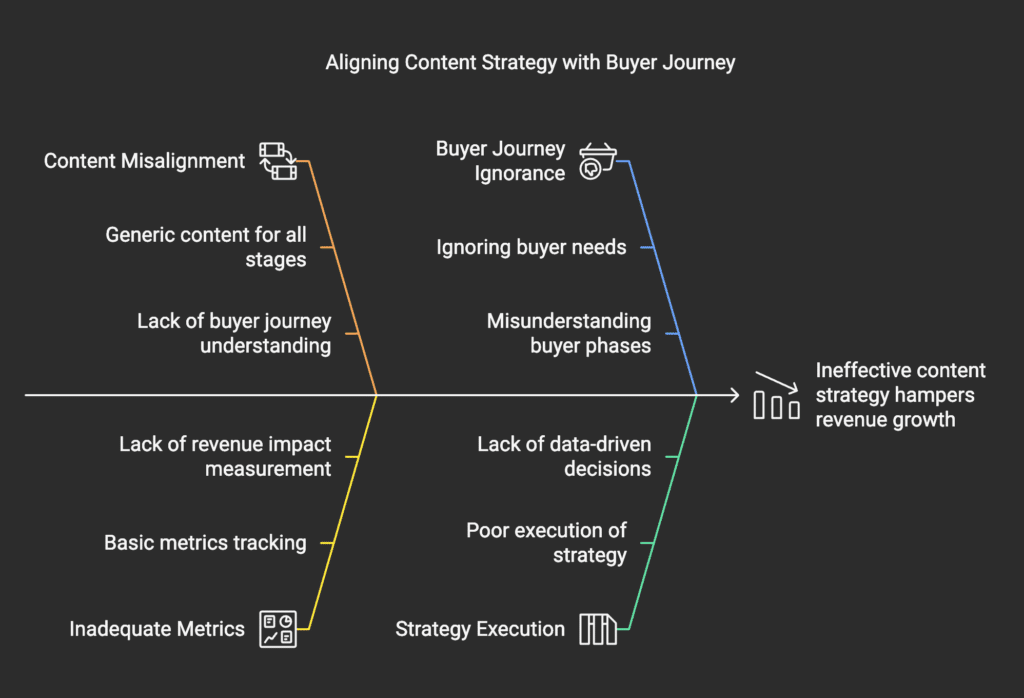Most B2B companies treat content like a buffet – putting out everything at once and hoping buyers will find what they need. The problem? Buyers at different stages need different types of content to make decisions.
B2B buyers spend significant time researching online and are 70% of the way down the funnel before talking to sales (SalesForce, 2024). But many companies miss this opportunity by creating content that doesn’t match where buyers are in their journey.
A buyer discovering their problem needs fundamentally different information than someone evaluating solutions. Yet most companies create content based on what they want to say rather than what buyers need to hear at each stage.
This post will show you how to create content that drives revenue by meeting buyers where they are:
- Match content types to each stage of the buying journey
- Measure if your content moves deals forward
- Build a content strategy that converts readers to revenue
- See how companies use targeted content to close deals faster
- Track content’s direct impact on pipeline and revenue
Why Every Stage of Your Buyer’s Journey Needs Different Content
A VP of Sales looks at your product differently than a CEO. A first-time researcher needs different information than someone comparing vendors. Yet 63% of marketers struggle to create content that speaks to these different stages (Content Marketing Institute, 2023).
Your buyers move through distinct phases before making a purchase. Understanding these phases changes how you create and deliver content that drives decisions:
- Awareness: They’ve just realized they have a problem. They’re searching for information, trying to understand if this issue is worth solving. Your content needs to validate their pain points and show possible solutions.
- Consideration: Now they’re evaluating approaches. They know they need to fix the problem, but they’re weighing different methods. Your content should show why your approach works better than alternatives. 47% of buyers read 3-5 pieces of content before talking to sales (Demand Gen, 2023). Case studies and detailed guides demonstrate your expertise and build credibility.
- Decision: They’re ready to choose a vendor. They need evidence you can deliver results. Case studies, implementation guides, and ROI calculators become crucial here. In fact, LinkedIn B2B Institute found buyers convert 70% more often when they see personalized, decision-focused content (2023).
- Retention: They’re using your product. They need content that helps them succeed and discover more value. Training materials and best practices keep them engaged.
- Advocacy: They’re seeing results. Now they can help tell your story. Customer spotlight content and success metrics turn them into vocal champions. 88% of buyers trust recommendations from peers more than any other marketing (Nielsen, 2023).
In order to connect and engage with your target ICP during their buying journey, you must align every piece of content with these stages. For example, a software company selling to marketing teams might create:
- Early stage: Posts about common marketing automation challenges
- Mid stage: Guides comparing different solution approaches
- Late stage: Case studies showing specific implementation results
- Post-purchase: Advanced feature tutorials and strategy guides
Turn Your Content Metrics into Revenue Insights
Most marketing teams track basic metrics like page views and downloads. But measuring content’s true impact on revenue demands a deeper look at how content influences decisions at each stage of your buyer’s journey.
According to HubSpot, while 92% of marketers know they need to track content ROI, only 29% feel confident in their measurements (2023). Let’s fix that by breaking down the metrics that actually matter at each stage.
Awareness Stage Metrics
Website traffic alone doesn’t tell the full story. Track these metrics to understand if your content reaches the right audience:
- Traffic from target accounts and industries
- Time spent on key educational pages
- Social engagement from decision-makers
- Return visits from qualified prospects
Consideration Stage Metrics
This stage reveals if your content moves prospects toward decisions:
- Lead-to-MQL conversion rates by content piece
- Email engagement with nurture content
- Resource downloads from target accounts
- Webinar attendance and participation rates
Decision Stage Metrics
These numbers show how content drives revenue:
- Content influence on pipeline opportunities
- Demo requests from content downloads
- Sales cycle length for content-engaged leads
- Conversion rates from trials to paid accounts
Retention Stage Metrics
Measure how content keeps customers engaged and growing:
- Product adoption rates tied to training content
- Feature usage after how-to content views
- Customer satisfaction scores post-education
- Expansion revenue influenced by content
Advocacy Stage Metrics
Track how content turns customers into champions:
- Referral rates from case study participants
- Social shares of customer success stories
- Testimonial completion rates
- Brand mention volume from customers
Building Your Measurement Framework
Connect these metrics to revenue by:
- Tracking content touch points throughout the buyer journey
- Measuring both engagement and business impact
- Attributing revenue influence to specific content pieces
- Identifying which content types drive the most valuable actions
This approach reveals not just what content performs well, but what content drives actual business growth. It moves measurement beyond vanity metrics to revenue impact.
Turn Your Content Into a Revenue-Driving Machine
Creating content without measuring its impact on revenue is marketing without a map. When you align your content with each stage of the buyer’s journey and track the right metrics, content transforms from an expense into a predictable source of growth.

The companies driving real results through content aren’t just creating more – they’re creating with purpose. Each piece of content serves a specific role in moving buyers toward decisions. Their content strategy isn’t based on gut feelings or industry trends, but on data showing what actually drives revenue.
Building this kind of revenue-focused content machine takes time.
But the math is simple: When you deliver the right information to the right person at the right stage of their journey, you accelerate decisions and grow pipeline.
Need help turning your content into a revenue driver? Let’s build a content strategy that actually moves your business forward. ☎️ Schedule a free consultation with me.





